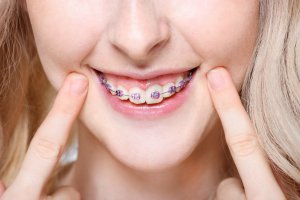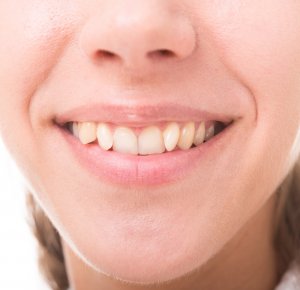Teeth straightening is a common dental procedure for people who are unhappy with the appearance of their teeth. It may be recommended by a dentist for medical reasons, or it may be a personal choice for cosmetic reasons. Either way, modern dentistry makes it possible to correct even severely misaligned bites.
Dental braces are a common solution to crooked teeth, but if you’re wondering how to straighten teeth without braces, or if there is a cheaper way to straighten teeth, the good news is there are other orthodontic and cosmetic teeth straightening options that might work for you.
Smile White treats most alignement problems, thanks to in-person monitoring by a dentist. However, unlike other brands and treatments, you only have 3 in-office visits — the rest of your treatment is done at home.
From mild adjustments to complex bite misalignment, Smile White can help.
Use code DENTALY5OFF to get 5% off your treatment.
In this article we will look at:
- The benefits of straight teeth
- Different braces options
- Ways to straighten teeth without braces (including aligners and veneers)
- Teeth straightening costs for different solutions
- The cheapest ways to straighten teeth safely
- Pros and cons of teeth straightening kits with remote monitoring
So, if you or your child have a less-than-perfect smile and you want to explore your treatment options, keep reading.
In This Article
The benefits of straighter teeth
You might think that teeth straightening is all about aesthetics, but there are actually some valid medical reasons for correcting misaligned teeth.
Crooked teeth can cause various problems, depending on the severity of the misalignment:
- Speech problems
- Difficulty eating
- Muscle strains
- Risk of damage to other teeth
- Problems maintaining good oral health
That last point can affect anyone with even slightly crooked teeth; if the teeth aren’t correctly aligned, it’s harder to clean them properly. This, in turn, means a greater likelihood of plaque buildup leading to tooth decay. A thorough oral health regime can help manage this risk.
While straightening your teeth can correct cosmetic problems and improve your smile’s appearance, it has even more benefits for your oral health. When a patient has crooked teeth, they often experience problems that interfere with their daily lives.
For example, crooked teeth can cause difficulty chewing or talking, but this issue can even contribute to jaw problems and damage to nearby teeth. Additionally, crooked teeth are more difficult to clean and care for, which means you could be more susceptible to problems like cavities and gum disease.
Dr. Travis R. Willey
Of course, appearance is also an important factor for many people, as this BBC article shows. Those who aren’t blessed with a perfect smile can be self-conscious about their teeth, and may opt to get them straightened even if there isn’t a medical need to do so.
We have a separate guide that covers the different types of malocclusion (bite misalignment). Here you can read about which malocclusions pose a medical risk, what causes crooked teeth in the first place, and possible treatments.
Teeth straightening options in the UK
Metal braces might be the first thing that comes to mind when you think about getting a straighter smile, but dentists can use different kinds of braces, including clear braces and removable aligners, to straighten teeth. There are also ways to straighten teeth without braces.
Ways to straighten teeth include:
- Traditional metal braces
- Clear or tooth-coloured ceramic braces
- “Invisible” aligner braces
- Home teeth straightening kits
- Retainers
- Veneers
We’ll cover each of these in more detail in just a moment, but the video below contains a brief overview of some of these teeth straightening options:
Teeth straightening surgery may be required to treat certain malocclusions such as a severe open bite, underbite, overbite or crossbite. This is usually done in conjunction with orthodontic work.
Can teeth be straightened at any age?
The best time to straighten teeth is in the teenage years, before the jaw bone and teeth roots are fully developed. This is why it’s important to take your child for regular dental checkups. If your dentist identifies a need for orthodontic treatment, he or she will plan this for the optimal time according to your child’s development.
That said, teeth straightening for adults is still very effective. Our teeth can change position as we get older, usually becoming more crooked, so teeth that used to be quite straight may start to bother you later in life. Or, perhaps you have always had wonky teeth but just never got braces as a child.
Whatever your age, if you’re unhappy with the way your teeth look then there are various ways to fix your smile.
Different types of braces for straightening teeth
First, let’s look at the different kinds of braces that are used for teeth straightening for adults, teens and children. You can read more about each of these by following the links in each section.
Metal braces

This is usually the cheapest way to straighten teeth with braces, and metal braces are the only way to get teeth straightening on the NHS.
Metal brackets are attached to the teeth and a wire is threaded through them to pull the teeth into position. Small elastic bands hold the wire in place – you can usually choose the colour of your elastics to add a touch of style to your braces. Adjustments take place every month or so.
Another option is self-ligating braces, which don’t need elastics; these ‘auto-adjust’ so don’t require such frequent adjustments. If your teeth are particularly crowded, you might need to have orthodontic spacers placed to create more room ahead of your braces being fitted.
If you are just looking for cheap braces, you may want to see what your options are before deciding on metal braces.
Clear braces
People who want a less noticeable option may consider clear braces to straighten their teeth. These work in the same way as metal braces but use ceramic materials which are clear or tooth-coloured, making them much less obvious.
Clear aligners (invisible braces)
If you want to straighten your teeth without braces fixed to your teeth, you’ll probably want to consider clear aligners. They are so discreet that they are also known as ‘invisible braces’.

These removable plastic devices straighten teeth by applying pressure in just the right places. You’ll get a new set every two weeks or so, and by wearing them for 20-22 hours a day, your teeth will gradually move into their new position.
Invisible braces work well for mild to moderate correction and can be a good, quick option – particularly if you just want to straighten your front teeth.
Aligners are very popular among people who don’t want it to be obvious that they are straightening their teeth – from teenagers to working professionals.
They also give you the flexibility to eat whatever you like, since you don’t have to worry about damaging any brackets or wires. You simply remove your aligners to eat and then replace them after cleaning your teeth afterwards. This is a benefit for some sports players, too.
Teeth straightening kits
Invisalign is one of the best-known brands of clear aligner, but they are also quite expensive. Cheaper options include NewSmile, which is purchased online and monitored remotely via an app.
Some of the benefits of home teeth straightening kits include:
- More affordable than in-office braces
- No dentist appointments every few weeks
- You can do everything from home
- Good for people with a dental phobia
At-home aligner options are not suitable for everyone, but you can take a free assessment here to see if you’re a good candidate. We also recommend you have a dental checkup before commencing any kind of teeth straightening, since you may need to have other oral issues treated first.
So, how can you straighten your teeth without actually visiting a dentist?
Teledentistry companies use a 3D scan of your mouth, or traditional teeth impressions, to see the current position of your teeth. Then, a dentist or orthodontist plans your treatment using a series of aligners. They send these to you in the post and you wear them as directed. You can check in with your dentist online to see how your treatment is progressing.
Treatment takes 4-6 months on average, although it can be longer if your case is more complex. There is also the option of nighttime aligners, which you wear for just 10 hours a day, but with an increased treatment duration.
- Up to 80% cheaper than Invisalign
- Buy now, pay later in interest-free instalments.
- Rated 4.5/5 on Trustpilot
- Starting at just 625 for single-arch treatment!
Caspersmile offers a convenient at-home solution for teeth straightening with their clear aligners. You can achieve a perfect smile in 3-5 months, wearing the aligners for 22 hours a day.
Caspersmile’s treatment is overseen by UK-licensed dentists, ensuring professional guidance throughout the process. The treatment starts with an at-home impression kit or a visit to a scan center, followed by a 3D preview of your future smile.
Every treatment comes with free teeth whitening, so you can brighten your smile while you straighten it!
- Hybrid in-office and remote treatment
- In-person visits with your orthodontist for safe, effective treatment
- Treats even complex cases of misalignment
- Various pricing options
Discover the flexibility and effectiveness of Impress Invisible Braces, the hybrid orthodontic solution that blends in-person care with the convenience of remote appointments. Suitable for both kids and adults, Impress offers a range of treatment options designed to cater to various needs, from mild to severe cases of misalignment. With the initial consultation happening in person, you’re assured of a tailored treatment plan that can address even the most complex orthodontic issues.
Impress Treatment Plans:
- Impress Super Light ($6,999): Perfect for mild cases, this plan promises results in up to 3 months, making it the quickest route to a better smile.
- Impress ($4,599): Designed for moderate cases, this option aims to perfect your smile within 4-10 months.
- Impress Plus ($5,599): Tailored for moderate cases requiring a bit more time, this plan spans 11-14 months.
- Impress Advanced ($6,999): The go-to choice for complex cases, offering comprehensive treatment over 11-24 months.
- Teens ($4,599): Specifically designed for teenagers, this plan addresses mild cases within 4-10 months, ensuring a confident smile during those crucial years.
- Impress Kids ($4,599): Offering orthodontic treatment for children, this plan covers a period between 8-18 months, setting the foundation for a lifetime of healthy smiles.
With flexible payment plans available, starting your journey to a perfect smile has never been easier or more accessible. Whether you’re looking for a quick fix or need extensive treatment, Impress Invisible Braces provide a tailored solution that meets your needs and budget. Click below to get started!
- Free retainers and whitening
- Nighttime aligners available
- 0% interest finance options
£1,395£1,295 or £83.33/month
NewSmile is a Canadian company that brought its clear aligners to the UK market in 2022. NewSmile aligners are made from the clearest material and the company offers excellent service at the best price.
They don’t have any physical locations, so you’ll need to purchase an aligner kit to get started. One of their Impression Specialists will guide you through the process on a video call when you’re ready.
NewSmile aligners are very affordable, costing just £1,395 (currently discounted to £1,295). But even better, this price includes whitening foam to use in your aligners, plus your first set of retainers!
Choose their daytime package for treatment in 4-6 months, or nighttime aligners for a more discreet treatment that takes 8-10 months. Both options come with 0% interest payment plans available.
Lingual braces
Also known as ‘hidden braces’, lingual braces are perhaps the least noticeable type of brace because they are fixed to the back of the teeth, next to the tongue. This means they are only visible when you open your mouth very wide.
However, they come at a price; they are the most expensive type of braces available, especially if you get a custom-made brand like Incognito braces.
If you’re concerned about aesthetics but still want a cheaper teeth straightening option, invisible braces might be the best solution.
How to straighten teeth without braces
Braces are the most effective way to straighten crooked teeth, and clear aligners are a popular option for people who want to avoid the look of traditional metal braces. Still, there are some alternative ways to straighten teeth that may work for you, depending on your circumstances.
Using a retainer for teeth straightening

Retainers are primarily used to retain the position of teeth following orthodontic work, hence the name. However, it is possible to achieve minor teeth straightening using a retainer or a device like the Inman Aligner.
Both clear retainers and metal retainers can straighten teeth to some degree, but the results are far more limited than with braces. Clear retainers might look the same as clear aligner braces, but they work differently.
If you’re looking for an affordable teeth straightening option for minor correction, especially after wearing braces in the past, then your dentist may offer a retainer. This can be adjusted slightly as treatment proceeds, but scope is far more limited than with braces.
Where greater movement is required, you’ll need to consider the other options. You can read more about the different types of retainers and costs in this guide.
Can veneers straighten crooked teeth?
Although veneers can’t change the position of teeth, they can make them look straighter. To achieve this, dentists drill down part of the crooked teeth and then fit a porcelain veneer over the top. The result is that the teeth look better aligned, even if underneath the original teeth are still crooked. This technique only works on mild cases.
Veneers can also be used to close small gaps between teeth. Read more about the process in our complete guide to teeth veneers.
Veneers can offer cheap teeth straightening prices compared to braces, depending on how many teeth need to be treated. This is also a much quicker treatment option, usually requiring just two appointments.
However, keep in mind that veneers are not a permanent fix. After 5-10 years they will need to be replaced, either with new veneers or with crowns. They often cause irreparable damage to the teeth underneath because of the enamel removal, so consider the long-term implications before going ahead.
Contouring and bonding
In certain cases, it’s possible to do less drastic cosmetic work by filing down parts of the teeth (e.g. rough edges and parts that protrude) and building other areas up with composite material. This procedure is known as composite bonding.
As with veneers, this can make the teeth appear straighter without having to move their position using braces.
Using mewing to straighten teeth naturally
Another teeth straightening technique you might have heard of is ‘mewing’. This basically involves consciously pushing the tongue against the roof of the mouth until it becomes the natural resting position.
We don’t recommend trying mewing to straighten teeth naturally, since this isn’t a proven benefit. It may help expand the palate when done correctly, and this can reduce problems with overcrowding. But if your teeth are already misaligned, chances are you need a dental appliance to straighten them.
It’s better to discuss your concerns with an experienced dentist who can advise you on the best treatment options.
How much does teeth straightening cost in the UK?
Teeth straightening in the UK costs from £1,300 to £10,000 with braces and from £50 to £1,000 per tooth without braces. See the table below for a better idea of costs with each method we’ve mentioned.
Cost | Pros | Cons | |
Metal braces | £1,500 - £3,000 | Usually the cheapest type of brace; may be offered on the NHS | Very noticeable |
Ceramic braces | £2,000 - £5,500 | Clear or tooth-coloured material is less noticeable | More expensive than metal |
Invisible braces | £1,300 - £5,500 | Removable and hard to notice | Require discipline; may not be suitable for severe malocclusions |
Lingual braces | £2,000 - £10,000 | Hidden behind teeth | Can be very expensive |
Porcelain veneers | £400 - £1,000 per tooth | Quick cosmetic fix | Not a permanent solution; damages tooth enamel |
Composite bonding | £100 - £300 per tooth | Quick cosmetic fix; cheap | Not a permanent solution; damages tooth enamel |
You can see that teeth straightening costs vary greatly depending on the method used. And, whereas braces are a permanent teeth straightening solution (provided you wear a retainer), veneers and bonding are only temporary, cosmetic treatments.
What’s the cheapest way to straighten teeth?
As you’ve seen above, at-home aligners are often the cheapest way to straighten teeth. They are only suitable for mild to moderate cases, but the company will tell you if you’re not a good candidate.
Of all the companies offering aligners in the UK, the cheapest one that we recommend is NewSmile. Their aligner package costs just £1,295, including whitening and a set of retainers.
For more significant teeth straightening, most people will need braces, in which case traditional metal braces or at-home clear aligners are usually most affordable.
When looking for teeth straightening near you, it’s a good idea to check prices from two or three dentists. Teeth straightening prices can vary quite considerably from one to another, so you may be able to save money that way.
You might also want to check out your dental finance options. There are ways to make teeth straightening prices more affordable, for example by spreading payments with a dental loan or payment plan.
Can you get teeth straightening on the NHS?
Children whose treatment has been deemed medically necessary can get free teeth straightening in the UK on the NHS. This covers metal braces and retainers, plus any surgery (if required). Our guide to braces for kids has more information about the eligibility criteria for children’s teeth straightening on the NHS.
Teeth straightening for adults is not provided by the NHS, except in extreme cases. It’s most likely you’ll have to pay for your treatment privately, but there are ways to make teeth straightening costs in the UK more affordable.
Summary
When deciding how to straighten your teeth – whether it’s a significant correction or just mild adjustment you need – there are several different options to consider.

Braces are the most common treatment for teeth straightening, whether metal or ceramic brackets fixed to the teeth, or clear aligners that straighten teeth without it being so obvious. You can visit a dentist for clear aligners, but there is also the option of remote treatment at home.
There are several brands of at-home clear aligners in the UK. These are becoming increasingly popular because they cost less than in-office braces, and you can complete your treatment entirely from home. NewSmile’s aligner packages start from just £1,295, so we recommend checking them out if this treatment is of interest to you.
Veneers may be appealing because they are so quick and convenient. Remember they are not truly straightening the teeth – just masking the problem. You need to consider the longer-term cost and inconvenience of replacing them when they fail.
Whatever you decide, we hope this article has helped you understand more about your teeth straightening options in the UK.
FAQs
How long do braces take to straighten teeth?
We can say that teeth straightening with braces takes 12-18 months on average, but it can be as little as 3-6 months in mild cases. More severe cases can take two years or more.
The type of braces you choose for your treatment will also affect your treatment time to some degree. It’s natural to want to know how long braces will take to straighten your teeth before you begin treatment, and your dentist should be able to give you a pretty good idea when you have your consultation.
Can you straighten teeth without braces?
Yes, there are some options for teeth straightening without braces. Clear aligners are very popular – these removable trays fit over the teeth to align them. Veneers can make teeth appear straighter.
If you want to avoid fixed braces, your dentist can explain the best solution according to your age and the condition of your teeth.
Can you use an old retainer to straighten teeth?
We don’t recommend it! It’s understandable that you want to save money, but using an old retainer may damage your teeth if they have moved out of position since you last wore it.
Retainers are designed to keep your teeth in place after braces. Follow your dentist’s instructions to keep your teeth straight following orthodontic work.
Can I use a night retainer to straighten teeth?
You may only need to wear a retainer at night to keep your teeth straight after braces, but aligners usually need to be worn for 20-22 hours a day for effective straightening. If your teeth aren’t under constant pressure to move, they’ll start slipping back to their old position during the downtime.
That said, some at-home aligner brands do offer a nighttime-only treatment option. Since you’re only wearing your aligners for 10 hours per day, your treatment time will be quite a bit longer.
Unless you really don’t want to wear aligners during the day, the regular treatment option is best as it works most efficiently. Remember, Invisalign aligners and other clear aligner braces are practically invisible, so you needn’t feel self-conscious about wearing them. Check here to see whether you’re eligible for invisible braces and understand more about your treatment options.
Can teeth straighten themselves?
It is only possible for teeth to straighten themselves while they are still erupting. The first few permanent teeth might come in crooked and then correct themselves as the other teeth erupt. In adults, though, teeth are likely to become more crooked over time, not straighter.
Can you get your teeth surgically straightened?
Jaw surgery may be carried out in addition to treatment with braces. This doesn’t surgically straighten individual teeth but it does re-align the jaw so that the teeth can come together properly.
Why is straightening teeth important?
Most people want straighter teeth for aesthetic reasons, but there are also some health benefits. Crooked teeth are harder to clean, and may lead to oral health problems like decay and gum disease. So, by straightening your teeth you are giving yourself a better chance of avoiding tooth decay and other problems in the future.
Gorton & Schimol Orthodontics: Can Retainers Fix A Slight Shift Of Teeth After Braces? Consulted 29th June 2019.
NHS: Braces and orthodontics. Consulted 29th June 2019.
Prices stated are indicative only and are based on publicised treatment prices at dental clinics across the UK.








